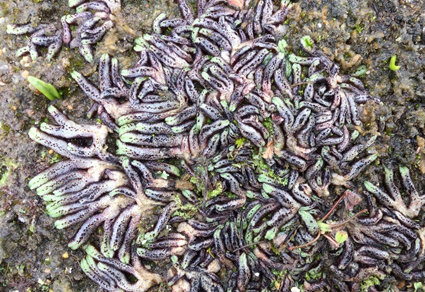Abstract
Riccia anguillarum Cargill, is described from Western Australia. This endemic species is distinguished by a fleshy, succulent thallus (similar to southern African species of Riccia in section Spongodes, group ‘Vesiculosa’). It is also unique within Riccia and the Ricciaceae in having a thallus of multilayered air spaces and a bi-layered capsule wall. A description of the new species with images, illustrations and map of its locations is provided.
Downloads
Download data is not yet available.
References
- Arnell, S.W. (1957) Hepaticae collected in South-West Africa by Prof. O.H. Volk. Mitteilungen der Botanischen Staatssammlung, München 2 (16): 262–272.
- Brundrett, M. (2021) One biodiversity hotspot to rule them all: southwestern Australia – an extraordinary centre for plant functional and taxonomic diversity. Journal of the Royal Society of Western Australia 104: 91–122. [https://www.rswa.org.au/publications/journal/104/RSWA%20104%20p91-122%20Brundrett.pdf]
- Cargill, D.C., Beckmann, K. & Seppelt, R. (2021) Taxonomic revision of Riccia (Ricciaceae, Marchantiophyta) in the monsoon tropics of the Northern Territory, Australia. Australian Systematic Botany 34: 336–430. https://doi.org/10.1071/SB20030
- Hopper, S.D. & Gioia, P. (2004) The Southwest Australian Floristic Region: Evolution and conservation of a global hot spot of biodiversity. Annual Review of Ecology, Evolution, and Systematics 35: 623–650. https://doi.org/10.1146/annurev.ecolsys.35.112202.130201
- Lindenberg, J.B.G. (1829) Synopsis Hepaticarum Europaearum. Nova acta Acadamiae Caesareae Leopoldino-Carolinae Germanicae Naturae Curiosorum Suppl. 14: 1–133.
- Linnaeus, C. (1753) Species plantarum, ed. 1. Laurentii Salvii, holmiae [Stockholm], 1200 pp.
- Morgan, M.J., Roberts, J.D. & Keogh, J.S. (2007) Molecular phylogenetic dating supports an ancient endemic speciation model in Australia’s biodiversity hotspot. Molecular Phylogenetics and Evolution 44: 371–385. https://doi.org/10.1016/j.ympev.2006.12.009
- Myers, N, Mittermeier, R.A., Mittermeier, C.G., da Fonseca, G.A.B. & Kent, J. (2000) Biodiversity hotspots for conservation priorities. Nature 403: 853–858. https://doi.org/10.1038/35002501
- Na-Thalang, O. (1980) A revision of the genus Riccia (Hepaticae) in Australia. Brunonia 3: 61–140. https://doi.org/10.1071/BRU9800061
- Nees von Esenbeck, C.G. (1838) Naturgeschichte der europäischen Lebermoose mit besonderer Beziehung auf Schlesien und die Örtlichkeiten des Riesengebirgs 4: 1–540.
- Perold, S.M. (1991a) A taxonomic revision of the Ricciaceae Reichenb. (Marchantiales: Hepaticae) in Southern Africa. PhD thesis, University of Pretoria, Pretoria. [http://hdl.handle.net/2263/23897]
- Perold, S.M. (1991b) Studies in the genus Riccia (Marchantiales) from southern Africa. 22. R. rubicollis, now validated, typified and described. Bothalia 21 (1): 51–54. https://doi.org/10.4102/abc.v21i1.858
- Perold, S.M. (1991c) Studies in the genus Riccia (Marchantiales) from southern Africa. 23. R. bullosa: typification and a full description. Bothalia 21 (2): 129–135. https://doi.org/10.4102/abc.v21i2.872
- Perold, S.M. (1999) Flora of South Africa: Hepatophyta. Part 1: Marchantiopsida. Fascicle 1: Marchantiidae. In: Leistner, O.A. (Ed.) Flora of Southern Africa. National Botanical Institute, Pretoria, pp. 1–252.
- Royal Horticultural Society (1995) ‘RHS Colour Chart.’ The Royal Horticultural Society: London, UK.
- Sim, T.R. (1926) The Bryophyta of South Africa. Transactions of the Royal Society of South Africa 15: 1–451. https://doi.org/10.1080/00359192609519311
- Takhtajan, A. (1986) Floristic regions of the world. University of California Press, Berkeley, 522 pp.


